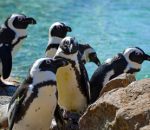Physical Description
African penguins, like all penguin species, are flightless birds. Instead, penguins use their small, dense feathers for insulation, repelling water, and protecting their skin. They are stiff contour feathers which overlap each other like shingles on a roof and help keep their skin dry. Underneath them is a thin layer of down feathers which hold a pocket of air. The contour feathers help trap that air and its heat next to the skin.
Having a body shaped like a torpedo or bowling pin helps make them more hydrodynamic so they can swim faster. Their belly is white and may have some black flecks on it, while their back is black. This is called countershading and provides them with camouflage in the water.
Predators
African Penguins have two main predators in the wild; these include sharks and sea lions. Their eggs are preyed upon by kelp gulls and sacred ibis as well as as well as large herons, Cape genet, mongoose, rats, domestic cats, and leopards. Humans also have been known to collect penguin eggs because they have been considered a delicacy.
Lifespan
The average life span for African penguins in the wild is 10-15 years. In human care, the average is 20-30 years.
Reproduction
Large colonies gather together on land when it is time to breed, molt, or rest. African penguins breed year-round, but it can vary depending on the year, season and colony. Primarily monogamous, African penguins will often form the same pair bonds every year. Males will court females with various physical displays, which she will respond to if she is receptive to his courting.
The female will then lay 1-2 eggs about 2-4 days apart. Incubation will last about 40 days. The parents will alternate incubating the eggs and foraging for food in the ocean. When penguin chicks hatch, they will be reliant on their parents for warmth, food, and protection for several weeks. When they are about 70-90 days old, they will finally grow their waterproof contours they need to begin heading into the water on their own.
Fun Facts
- African penguins experience an annual catastrophic molt. Over a period of approximately 18 days, they will replace all of their feathers, and during this time, they will be unable to feed because their downy feathers exposed during the molt are not waterproof.
- While diving for food, they average depths of 16-80 feet but can reach depths of up to 300 feet! Having solid, heavy bones (unlike most birds, which have hollow bones), also helps them with be able to dive deeper.
Conservation Messaging
South African penguins are considered endangered but there are many ways we can help their populations in the wild. One easy way to do this is to choose sustainable seafood options. You can download the Seafood Watch smartphone application by Monterey Bay Aquarium to ensure the seafood you’re purchasing is sustainably sourced. You can also download their pamphlet which will provide you with the best fish choices, appropriate alternatives, and certain fish species to avoid when fishing or purchasing food. Making smart and sustainable choices will help ensure that penguins in the wild are left with plenty of fish to eat!
To learn more about the Monterey Bay Aquarium’s Seafood Watch App, visit: seafoodwatch.org.
Another great organization to support is the Southern African Foundation for the Conservation of Coastal Birds or (SANCCOB). SANCCOB is located in South Africa and actually helps rescue, rehab, and release South African Penguins which is helping their wild populations. You can help SANCCOB sustain their mission by donating or by “adopting” a penguin that is currently undergoing care. To learn more or to make a donation, visit: www.sancobb.org.

